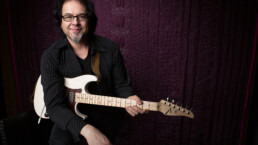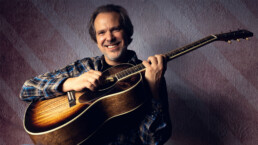FREE LESSONS: Jackie Venson's Electric Joy
Grab your guitar and dial in Electric Joy, an immersive journey into the heart of musical expression through the lens of one of our generation's most dynamic and soulful guitarists, Jackie Venson.
Electric Joy unfolds across a meticulously curated selection of 10 tracks, each serving as a gateway to different facets of Jackie’s groundbreaking guitar artistry. From the energetic grooves of "Witchcraft" to the soulful depths of "Love Transcends," Jackie guides you through her creative approaches and techniques, sharing insights, influences, and the sheer joy of playing guitar.
"I let the soul of the guitar seep into me. I draw on my emotions, my feelings, and the life I've lived. And that connection and storytelling is the cornerstone of my guitar inspiration.”
Enjoy these free lessons from Jackie Venson. Get the full Jackie Venson Bundle here >
Witchcraft | Rhythm - Performance
Always Free - Overview
Always Free | Rhythm - Performance
Always Free | Rhythm - Breakdown
Electric Joy is more than a masterclass; it's an invitation to journey with Jackie Venson as she shares her love for the guitar, her musical insights, and her creative spirit. Through interactive lessons, personal anecdotes, and a focus on creative freedom, Jackie inspires guitarists to find their joy in music, pushing the boundaries of what it means to play the guitar.
"How I play the guitar showcases my best, most unfiltered self. I let the soul of the guitar seep into me.”
You’ll have TrueFire’s interactive learning tools at your fingertips to personalize your workspace and learn at your own pace.
The demonstrations and performances are tabbed, notated, and synced to the video with controls for looping, slow motion, fretboard animation, and many other tools designed to accelerate learning.
You’ll also get tab and standard notation files to print out, Guitar Pro files, and backing tracks to practice with.
Grab your guitar, and share the joy with Jackie Venson!
P.S. Check out Jackie’s companion Electric Joy edition of In The Jam. Dial in your mix and jam over all ten of the tracks featured here in the masterclass!
Unlocking Mastery: The Crucial Importance of Daily Guitar Practice
In the realm of music, mastery isn't a destination; it's a journey—a journey paved with dedication, discipline, and daily guitar practice. Whether you're a beginner strumming your first chords or a seasoned player refining your craft, the significance of consistent practice cannot be overstated. Let's delve into why daily guitar practice is the cornerstone of musical proficiency and how it can transform your playing.
RELATED: Form a new practice routine with JamPlay + TrueFire All Access >
The Power of Consistency
Imagine a sculptor crafting a masterpiece out of a block of marble. Each day, they chisel away, refining the contours, and shaping it into something extraordinary. Similarly, daily guitar practice chips away at the rough edges of your skills, honing your technique, and molding you into a proficient musician.
Consistency breeds familiarity. The more regularly you engage with your instrument, the more intimate your relationship with it becomes. Your fingers learn to dance effortlessly across the fretboard, and your muscle memory kicks in with precision, allowing you to execute complex maneuvers with ease.
Building Blocks of Mastery
Guitar practice isn't just about mindlessly strumming chords or running scales—it's about deliberate, focused effort. Each practice session is an opportunity to deconstruct your playing, identify areas for improvement, and work systematically towards mastering them.
By breaking down challenging passages into smaller, manageable chunks, you can tackle them methodically, gradually increasing your proficiency. Whether it's mastering a tricky riff, perfecting your timing, or refining your tone, daily practice allows you to make incremental progress that compounds over time.
Cultivating Discipline and Patience
In a world of instant gratification, mastering the guitar is a testament to the virtues of patience and perseverance. Progress may seem slow at times, but every hour spent practicing is an investment in your musical journey. It's about embracing the process, trusting in your abilities, and staying committed to your goals.
Daily guitar practice instills discipline—an unwavering commitment to show up, even on days when inspiration wanes or life gets hectic. It teaches you to push through obstacles, overcome challenges, and emerge stronger on the other side. As the saying goes, "Rome wasn't built in a day," and neither is musical mastery.
Unlocking Creativity and Expression
Beyond technical proficiency, daily guitar practice fosters creativity and self-expression. It's a medium through which you can channel your emotions, tell stories, and connect with others on a deeper level. Whether you're composing original music, improvising over a jazz standard, or simply jamming with friends, the guitar becomes a vehicle for artistic exploration.
Through consistent practice, you develop your unique voice as a musician, honing your style and refining your sonic palette. Each note becomes imbued with intentionality, each chord progression a canvas upon which you paint your musical narrative. It's a journey of self-discovery—one that unfolds with every strum and pluck of the strings.
Conclusion: Embrace the Journey
In the pursuit of musical excellence, daily guitar practice is not merely a habit; it's a mindset—an unwavering commitment to growth and self-improvement. It's about showing up each day, ready to challenge yourself, push your boundaries, and evolve as a musician.
So, pick up your guitar, set aside time each day, and immerse yourself in the transformative power of practice. Embrace the journey, celebrate the small victories, and trust in the process. Remember, mastery is not an endpoint—it's a lifelong odyssey fueled by passion, dedication, and the timeless art of guitar practice.
RELATED: Form a new practice routine with JamPlay + TrueFire All Access >
Rob Garland's Essential Blues Chord Voicings: Free Course Samples!
Unleash the Soulful Sound of Blues Chords with Rob Garland in "Essential Blues Chord Voicings," an exclusive online guitar course available only on TrueFire, produced in collaboration with JamPlay. Designed for guitarists of all levels, this course is your gateway to mastering the foundational chord voicings that define the rich and emotive sound of the blues.
RELATED: Get Rob Garland's Essential Blues Chord Voicings on TrueFire >
Through 38 in-depth lessons, you'll learn a variety of chord shapes, voicings, inversions, and progressions that will add depth and color to your blues playing. From classic 12-bar blues progressions to jazz-infused blues chords, this course covers a wide range of styles and variations. You'll explore dominant 7th chords, bluesy extensions, essential blues turnarounds, and more. With practical examples, play-along exercises, and insightful explanations, you'll develop the skills to create authentic and expressive blues chord progressions.
TrueFire's interactive learning platform ensures an immersive and engaging experience. High-definition video lessons, on-screen chord diagrams, and supplemental practice materials make it easy to follow along and reinforce your understanding of each concept. You'll have the flexibility to learn at your own pace, revisit lessons as needed, and track your progress as you build your chord vocabulary. Elevate your blues guitar playing with "Essential Blues Chord Voicings." Unlock the secrets of soulful blues chords, infuse your playing with authenticity, and captivate listeners with your mastery of blues progressions. Enroll today and discover the transformative power of blues chord voicings.
Free Course Samples
A7 Funky 12 Bar Blues - 2nd Position
8 Bar Open Blues Position
Bb7 Funky 12 Bar Blues
Blues 7sus9
RELATED: Get Rob Garland's Essential Blues Chord Voicings on TrueFire >
The acoustic guitar, with its warm tones and timeless appeal, has played an integral role in the evolution of music. From humble origins to becoming a global icon, the acoustic guitar's journey is a fascinating tale of craftsmanship, innovation, and cultural influence. In this blog post, we'll explore the rich history of the acoustic guitar and its connection to modern education through platforms like JamPlay, a leading guitar education company.
RELATED: Get a Free Trial of JamPlay + TrueFire All Access >
Origins and Early Evolution:
The roots of the acoustic guitar can be traced back centuries, with the lute and other stringed instruments paving the way for its development. In the 19th century, Spanish luthiers such as Antonio Torres pioneered the modern design we recognize today. The emergence of steel-string guitars in the early 20th century added a brighter, more versatile sound, making the acoustic guitar a staple in various musical genres.
Cultural Influence and Iconic Moments:
The acoustic guitar has left an indelible mark on cultural movements and pivotal moments in history. From the folk revival of the 1960s, where it became a symbol of protest and self-expression, to intimate performances in coffeehouses, the acoustic guitar's versatility has made it a companion for storytellers, troubadours, and musicians across the globe.
Innovation and Modern Advancements:
As technology advanced, so did the acoustic guitar. From the introduction of pickups for amplified performances to the development of high-quality tonewoods, luthiers and manufacturers continuously pushed the boundaries of craftsmanship. Today, acoustic guitars come in various shapes, sizes, and styles, catering to the diverse preferences of musicians worldwide.
JamPlay: Bridging Tradition and Innovation in Guitar Education:
As the acoustic guitar evolved, so did the methods of learning and teaching. JamPlay, a pioneering guitar education company, has embraced this evolution by providing a platform that combines tradition with modern teaching techniques.
- Comprehensive Lessons & Courses: JamPlay offers a vast library of lessons, covering everything from basic chords to advanced fingerstyle techniques, ensuring that players of all levels can find valuable content to enhance their skills.
- Expert Instructors: JamPlay features a roster of accomplished instructors who bring their expertise to the virtual classroom, guiding students through the intricacies of acoustic guitar playing.
- Interactive Learning: JamPlay's platform encourages interactive learning, allowing students to engage with lessons at their own pace. With features like video lessons, interactive tabs, and more, aspiring guitarists can refine their skills in a dynamic and supportive environment.
- Diverse Genres: Just as the acoustic guitar has ventured into various musical genres throughout history, JamPlay's curriculum spans a wide range of styles, ensuring that students can explore and master the nuances of their preferred genres.
Conclusion:
The history of the guitar is a testament to its enduring appeal and cultural significance. Today, platforms like JamPlay bridge the gap between tradition and innovation, providing aspiring guitarists with the tools and knowledge needed to continue the acoustic guitar's rich legacy. As we strum through time, the acoustic guitar remains a timeless instrument, and JamPlay stands as a guide, helping enthusiasts unlock their full potential in the world of acoustic guitar playing.
RELATED: Get a Free Trial of JamPlay + TrueFire All Access >
February 20, 2024
Love and music have always shared an inseparable bond, and what better way to express affection than through heartfelt melodies played on the guitar? Whether you're serenading a significant other, expressing your emotions, or simply enjoying the beauty of love songs, the guitar offers a perfect platform for conveying the depth of emotions. Here, we present the top five love songs that are not only timeless classics but also beautifully suited for guitar renditions.
RELATED: Learn to play love songs with JamPlay + TrueFire >
"Wonderful Tonight" by Eric Clapton
Eric Clapton's "Wonderful Tonight" is an evergreen love ballad cherished by generations. Its simple yet profound lyrics, coupled with a melodic progression, make it an ideal choice for guitar serenades. The song's gentle tempo and emotive chord changes resonate deeply, creating an enchanting ambiance for expressing love through music.
"Can't Help Falling in Love" by Elvis Presley
Few songs capture the essence of love as elegantly as Elvis Presley's "Can't Help Falling in Love." Its iconic melody and heartfelt lyrics have made it a timeless classic, perfect for romantic moments. When played on the guitar, the song's soft arpeggios and tender chords evoke a sense of nostalgia and romance, making it an exquisite choice for serenading loved ones.
"Hallelujah" by Leonard Cohen (Covered by Jeff Buckley)
Leonard Cohen's "Hallelujah," famously covered by Jeff Buckley, is a hauntingly beautiful ode to love and longing. Its poignant lyrics and soul-stirring melody have resonated with listeners worldwide. When interpreted on the guitar, the song's emotive chord progressions and delicate fingerpicking patterns create an intimate atmosphere, making it a poignant choice for expressing deep emotions.
"Your Song" by Elton John
Elton John's "Your Song" is a timeless declaration of love, celebrated for its heartfelt lyrics and soulful melody. Its simple yet profound composition lends itself perfectly to guitar interpretations. The song's gentle chord changes and melodic phrasing offer ample opportunities for expressive playing, allowing guitarists to convey the sincerity and depth of their emotions through music.
"I Will Always Love You" by Whitney Houston (Written by Dolly Parton)
Whitney Houston's rendition of "I Will Always Love You" is an iconic anthem of enduring love and heartfelt farewells. Originally written and performed by Dolly Parton, the song's powerful vocals and emotive melody have made it a classic in the realm of love songs. When adapted for the guitar, the song's soaring melody and heartfelt lyrics take on a new intimacy, allowing guitarists to convey profound emotions through their playing.
Each of these love songs holds a special place in the hearts of listeners, and when played on the guitar, they become even more poignant and intimate. Whether you're serenading a loved one or simply indulging in the beauty of love songs, these timeless classics offer a perfect soundtrack for expressing the depth and sincerity of your emotions through music. So, pick up your guitar, strum a few chords, and let the power of music convey what words alone cannot express – the beauty of love.
RELATED: Learn to play love songs with JamPlay + TrueFire >
February 14, 2024
Strings of Glory: The Top 5 Super Bowl Halftime Shows that Struck a Chord with Guitar Enthusiasts
While the Super Bowl is undoubtedly a spectacle for football fans, it has also become a haven for guitar music enthusiasts, especially those who appreciate the artistry of the guitar. Over the years, guitar legends and contemporary artists alike have graced the Super Bowl stage, delivering performances that struck a chord with audiences worldwide. In this blog, we'll dive into the top 5 Super Bowl halftime shows that showcased the guitar's prowess and left us mesmerized.
RELATED: Learn how to play guitar and be the NEXT big entertainer at the Super Bowl >
Prince - Super Bowl XLI (2007):
Prince's halftime show in 2007 wasn't just a musical performance; it was a guitar masterclass. Despite the rain, Prince wowed the audience with his virtuosity on the guitar during his rendition of "Purple Rain." The iconic silhouette against a backdrop of raindrops is etched in our memories as one of the most powerful and visually stunning moments in Super Bowl history.
Watch Prince's Super Bowl XLI Performance
U2 - Super Bowl XXXVI (2002):
U2's halftime show wasn't just a celebration of their hits; it was a heartfelt tribute. The Edge, U2's lead guitarist, delivered soul-stirring guitar solos during "Where the Streets Have No Name" and "Beautiful Day." His atmospheric, delay-laden soundscapes demonstrated the emotive power of the guitar, creating a moving experience that resonated with viewers.
Watch U2's Super Bowl XXXVI Performance
Tom Petty and the Heartbreakers - Super Bowl XLII (2008):
Tom Petty's halftime show was a rock 'n' roll spectacle that highlighted the enduring appeal of classic guitar-driven music. As the lead guitarist and vocalist, Petty and his band, The Heartbreakers, delivered a set that included "Free Fallin'" and "Running Down a Dream." The straightforward yet powerful guitar riffs showcased the timeless allure of rock music.
Watch Tom Petty's Super Bowl XLII Performance
Slash featuring Fergie - Super Bowl XLV (2011):
When Slash, the legendary guitarist of Guns N' Roses, joined forces with Fergie for the halftime show, it was a rock collaboration like no other. Their performance of "Sweet Child o' Mine" brought the electric guitar to the forefront, with Slash's iconic riffs complementing Fergie's vocals. It was a moment that bridged the gap between rock and pop on the grand Super Bowl stage.
Watch Slash and Fergie's Super Bowl XLV Performance
Bruce Springsteen and the E Street Band - Super Bowl XLIII (2009):
The Boss, Bruce Springsteen, and his E Street Band brought pure rock energy to the Super Bowl halftime show in 2009. Springsteen's dynamic stage presence was matched by the powerful guitar work of Nils Lofgren and Steven Van Zandt. Their performance of "Born to Run" and "Glory Days" was a testament to the enduring power of the guitar in the landscape of American rock music.
Watch Bruce Springsteen's Super Bowl XLIII Performance
Conclusion:
The Super Bowl halftime shows have not only been a showcase of musical talent but also a celebration of the guitar's versatility and emotive power. From Prince's mesmerizing solos to U2's atmospheric soundscapes, Tom Petty's classic rock appeal, Slash's electric riffs, and Bruce Springsteen's energetic anthems, these performances have left an indelible mark on the intersection of football and music. As we anticipate future Super Bowl halftime shows, guitar enthusiasts eagerly await the next maestro to step onto the grand stage and make those strings sing.
RELATED: Learn how to play guitar and be the NEXT big entertainer at the Super Bowl >
YES! Even You Can Learn To Play Fingerstyle Guitar
For many aspiring musicians, the dream of playing fingerstyle guitar feels just out of reach. Whether it's doubts about hand size, musical inclination, or the potential to develop the necessary skills, these barriers can seem insurmountable. However, the truth is far more encouraging. Let's embark on a journey to debunk these misconceptions, explore the rewarding aspects of learning fingerstyle guitar, and share some practical tips to set you on the path to mastery.
RELATED: Get Dave Isaacs's New TrueFire Course, Hands-on Fingerstyle Vol. 1 >
Debunking Common Misconceptions
Misconception 1: "My hands and fingers aren't suitable."
One of the most pervasive myths is that only those with a certain hand or finger type can excel at fingerstyle guitar. The reality is that fingerstyle guitar is about technique, not physical attributes. Musicians with various hand sizes and shapes have mastered this style. The key is to learn proper technique and adapt it to your physical characteristics.
Misconception 2: "I'm not musically inclined."
Many believe that a natural talent for music is a prerequisite for learning an instrument. While innate musicality can be advantageous, it's not a requirement. Fingerstyle guitar, like any skill, can be learned and refined over time. It's more about persistence and practice than any inherent musical gift.
Misconception 3: "I don't have the potential to develop the skills."
This belief often stems from a fear of failure or from comparing oneself to others who seem to progress more quickly. Remember, everyone's musical journey is unique. With dedication, patience, and the right guidance, anyone can develop the skills necessary for fingerstyle guitar.
10 Reasons Why Learning Fingerstyle Guitar is Rewarding
Personal Expression
Fingerstyle guitar allows for a wide range of emotional expression, making it a deeply personal and rewarding experience.
Versatility
This style is versatile, applicable to various genres, from classical and jazz to pop and folk.
Improves Coordination
Learning fingerstyle guitar enhances hand-eye coordination and dexterity.
Brain Boost
It stimulates the brain, enhancing cognitive functions and memory.
Solo Performances
With fingerstyle, you can provide both melody and harmony, making solo performances rich and full.
Creative Outlet
It offers endless creative possibilities, encouraging you to experiment and create your arrangements.
Mindfulness and Relaxation
Playing guitar can be a meditative experience, reducing stress and promoting mindfulness.
Community and Connection
Joining the fingerstyle community opens up opportunities for connection and inspiration.
Life-Long Learning
Guitar playing offers continuous learning opportunities, keeping the hobby fresh and engaging.
Personal Achievement
Mastering a piece or technique provides a sense of achievement and boosts self-confidence.
10 Tips for Learning Fingerstyle Guitar
Start with the Basics
Begin with simple exercises to build finger strength and flexibility. Focus on proper hand positioning to avoid strain.
Slow and Steady Wins the Race
Practice slowly to ensure accuracy before increasing speed. Muscle memory develops with time, not speed.
Use Quality Resources
Invest in quality learning materials, such as tutorials from reputable instructors or well-reviewed online courses.
Practice Regularly
Consistency is key. Even short, daily practice sessions can lead to significant progress over time.
Listen and Learn
Listen to fingerstyle masters to understand different styles and techniques. Try to emulate the tones and emotions they convey.
Focus on Timing and Rhythm
Metronome practice can greatly improve your timing and rhythm, crucial aspects of fingerstyle playing.
Experiment with Fingerpicks
Fingerpicks can enhance your sound and protect your fingers. Experiment with different types to find what works best for you.
Record Yourself
Recording your practice sessions can help you identify areas for improvement and track your progress over time.
Stay Patient and Positive
Progress may be slow at times. Stay patient and maintain a positive mindset. Celebrate small victories along the way.
Join a Community
Connect with other fingerstyle guitarists. Sharing experiences and tips can be incredibly motivating and educational.
In conclusion, learning fingerstyle guitar is a journey filled with challenges, but it's also immensely rewarding. By debunking common misconceptions, understanding the benefits, and following practical tips, you're well on your way to enjoying one of the most fulfilling hobbies for life. Remember, the only true barrier to learning fingerstyle guitar is the belief that you can't overcome the obstacles in your path. With dedication and the right approach, you'll discover that, yes, even you can master the art of fingerstyle guitar.
RELATED: Get Dave Isaacs's New TrueFire Course, Hands-on Fingerstyle Vol. 1 >
Embarking on the journey to become a skilled guitarist is a thrilling adventure, filled with musical exploration. However, in the eagerness to become a guitar virtuoso overnight, many budding musicians often underestimate the significance of pacing themselves. In the realm of guitar lessons, it's crucial to adopt a marathon mentality rather than sprinting towards mastery. In this blog, we'll delve into the importance of pacing your learning journey and how platforms like JamPlay and TrueFire can be your ultimate allies in achieving proficiency at your own pace.
RELATED: Get a free trial of JamPlay + TrueFire All Access >
The Marathon Mentality:
Successfully learning a musical instrument requires a marathon mentality for sustained success. Instead of hurrying through lessons to hastily reach your goals, building a solid foundation and progressing gradually is key. Pacing yourself ensures a thorough understanding of fundamental techniques, chords, and scales, laying the groundwork for advanced skills.
The Perils of Sprinting:
Racing through guitar lessons without a steady pace can lead to frustration and burnout, much like attempting a sprint without proper warm-up or stretching. Learning to play the guitar is a gradual process that demands time, dedication, and patience. Trying to absorb too much information in a short period may overwhelm and discourage even the most enthusiastic learners.
JamPlay and TrueFire: Your Pacing Partners:
In the digital era, online guitar lesson platforms have transformed the landscape of music education. Both JamPlay and TrueFire stand out as leading platforms that recognize the importance of pacing in the learning process. Offering extensive libraries of high-quality video lessons, courses, and jam tracks, JamPlay and TrueFire empower guitarists to tailor their learning experience to their own pace and preferences.
Key Features of JamPlay and TrueFire:
Structured Courses: Both JamPlay and TrueFire present a diverse array of courses catering to various skill levels. From foundational basics to advanced techniques, each course is thoughtfully structured to facilitate steady progress, ensuring a comprehensive understanding of the material.
On-Demand Learning: Unlike traditional guitar lessons with fixed schedules, JamPlay and TrueFire enable you to learn at your convenience. Access lessons whenever and wherever you desire, providing the flexibility to integrate learning into your busy lifestyle.
Interactive Tools: JamPlay and TrueFire offer interactive tools such as video lessons, tablature, and play-along features, enhancing the learning experience. These tools assist in grasping concepts effectively and applying them in practical musical contexts.
Diverse Genres and Styles: Whether your musical taste leans towards blues, rock, jazz, or any other genre, both JamPlay and TrueFire provide a vast array of lessons. This diversity allows you to explore different styles at your own pace, broadening your musical horizons.
Conclusion:
In the marathon of mastering the guitar, pacing is the key to reaching the finish line with confidence and proficiency. JamPlay and TrueFire create an ideal environment for this journey, offering a wealth of resources customizable to your individual learning style. Remember, it's not about how fast you play but how well you understand and enjoy the process. So, strap on your guitar, set your own pace, and let JamPlay and TrueFire be your trusted companions in the musical marathon of a lifetime.
RELATED: Get a free trial of JamPlay + TrueFire All Access >
February 7, 2024
There's something magical about sitting around a campfire, surrounded by the warmth of flickering flames and the company of friends and family. What better way to enhance this experience than by strumming along to some timeless campfire songs on your trusty guitar? In this blog, we'll explore the top 5 campfire songs that are not only crowd-pleasers but also perfect for guitar enthusiasts of all skill levels. Get ready to create unforgettable memories with these classics.
RELATED: Get a 14 Free Trial of JamPlay + TrueFire All Access >
"Wagon Wheel" by Old Crow Medicine Show
"Wagon Wheel" has become a modern campfire anthem, combining folk and country elements to create a feel-good sing-along. The chords you need to know are G, D, Em, and C.
"Wonderwall" by Oasis
No campfire gathering is complete without someone strumming the opening chords of "Wonderwall." This iconic 90s song is a favorite among guitar players. The chords for "Wonderwall" are relatively simple, involving Em, G, D, A7sus4, and Cadd9.
"Country Roads" by John Denver
Take your fellow campers on a journey to the West Virginia mountains with the timeless classic "Country Roads." The chords for this song are G, Em, D, and C.
"Fire and Rain" by James Taylor
For a more mellow and reflective campfire moment, "Fire and Rain" by James Taylor is an excellent choice. The chords include D, A7, Bm, G, and Em.
"Brown Eyed Girl" by Van Morrison
Bring some soulful vibes to the campfire with "Brown Eyed Girl." This feel-good classic features the chords G, C, D, and Em.
Conclusion:
Whether you're a seasoned guitarist or just starting out, these campfire songs provide the perfect soundtrack for your outdoor gatherings. So, grab your guitar, gather your friends, and let the music flow around the crackling flames. Happy strumming!
RELATED: Get a 14 Free Trial of JamPlay + TrueFire All Access >
February 1, 2024
For many guitarists, the six-stringed instrument is their first love, their trusty companion in musical exploration. However, there exists another member of the stringed family that often gets overlooked but holds immense potential for enhancing one's musicality: the bass guitar. In this blog, we'll delve into the reasons why guitarists should consider learning to play bass guitar alongside their standard guitar, exploring the unique benefits that come with mastering both instruments.
RELATED: Get a Free Trial of JamPlay + TrueFire All Access for Bass >
Understanding Rhythm and Groove:
One of the most significant advantages of learning to play bass guitar is gaining a deeper understanding of rhythm and groove. While guitarists certainly develop rhythmic sensibilities through strumming and picking techniques, the bass guitar places a particular emphasis on anchoring the rhythm section of a band. By learning to lock in with the drummer and establish a solid groove, guitarists who also play bass can enhance their overall musicality and become more versatile performers.
Enhancing Melodic Awareness:
While the bass guitar is primarily known for its role in providing the foundation of a song's harmony, it also offers ample opportunities for melodic expression. By learning to play bass, guitarists can expand their melodic awareness by exploring different note choices, scales, and phrasing techniques. This expanded harmonic and melodic vocabulary can greatly enrich their compositions and improvisations on both instruments.
Strengthening Musical Collaboration:
In many musical settings, the bass player and guitarist work closely together to create a cohesive sound. By understanding the role and perspective of each instrument, guitarists who also play bass can foster stronger musical collaborations within bands or ensembles. This dual proficiency allows for better communication, tighter arrangements, and more creative interplay between instruments, ultimately leading to more dynamic and engaging performances.
Diversifying Musical Opportunities:
In today's music industry, versatility is key. By mastering both guitar and bass guitar, musicians open themselves up to a wider range of musical opportunities. Whether it's joining a new band as a bassist, participating in studio sessions, or even pursuing solo projects that incorporate elements of both instruments, dual proficiency can significantly increase one's versatility as a musician and open doors to new creative possibilities.
Deepening Appreciation for Music:
Lastly, learning to play bass guitar alongside standard guitar can deepen one's overall appreciation for music. By gaining insight into the unique roles and responsibilities of each instrument within a musical ensemble, guitarists can develop a greater appreciation for the intricacies of arrangement, composition, and performance. This holistic understanding of music can enrich their listening experiences and inform their approach to playing both instruments.
Conclusion:
In conclusion, the bass guitar offers guitarists a wealth of benefits that extend beyond simply mastering another instrument. From improving rhythm and groove to enhancing melodic awareness and fostering stronger musical collaborations, learning to play bass guitar alongside standard guitar can broaden one's musical horizons and deepen their overall appreciation for music. So, if you're a guitarist looking to take your skills to the next level, consider picking up a bass guitar and exploring the exciting world of dual instrument proficiency. Your musical journey will be all the more rewarding for it.
RELATED: Get a Free Trial of JamPlay + TrueFire All Access for Bass >
January 30, 2024










